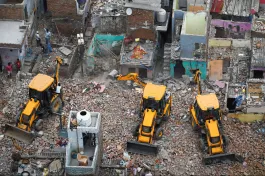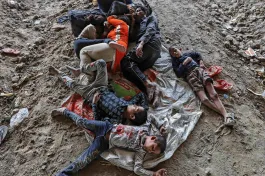Addressing the second convocation at the All India Institute of Medical Sciences (AIIMS) in 1964, Jawaharlal Nehru was poignant. “One thing that troubles me is that in spite of such fine institutes as this one, yet there are vast areas in this country […] where the benefits of modern medicine do not reach,” he said. “I will suggest to you, those who trained, have received the benefit of training at these special institutes, should always bear in mind the need of the people in India who live in the villages” (42).
Sixty years down, Anna Ruddock writes in her Special Treatment: Student Doctors at the All India Institute of Medical Sciences, “AIIMS has largely failed in its founding mission to systematically produce teaching clinicians for the country, not least due to the lack of supporting infrastructure.” In complete contrast to the hope of Jawaharlal Nehru, a career as a village doctor would be viewed as a failure for an AIIMS graduate. The pinnacle of success is securing an appointment as a tenured faculty at a North American University (164).
Through an analysis of the process of admission, pedagogy, aspirations, and attitudes of the students, and some interactions with the faculty, Ruddock examines the role of medical education in general and AIIMS in particular, in solving the health needs of the country.
‘The best’
The government of newly independent India established AIIMS in 1956, following up on a decade-old plan for a central institute to “produce the future leaders of Indian medicine and public health, the teachers and research workers” (31-33). The original idea was for a centre modelled on Johns Hopkins University in the United States, probably because the Johns Hopkins Medical Centre was explicitly expected to combine patient care with teaching and research. While presenting the bill to establish the institute, Health Minister Amrit Kaur told Parliament that “Medical education must, above all, take into account the special needs of the country from the point of view of affording health protection to the people” (38).
The campus experience and the faculty and peer group experiences at AIIMS do not inculcate in students an interest in the national “needs” that Nehru and Kaur spoke of.
“Who is AIIMS for?” This question posed to Ruddock, by a member of AIIMS is the underlying theme of the book. As she says “AIIMS is less interested in the potential of medicine as a social profession and more concerned with reproducing its elite character” (66).
There is an exaggerated sense of exceptionalism amongst both students and faculty at AIIMS. The statement that AIIMS is “the best” was repeated by many of the people whom Ruddock spoke to. When I was a student in the mid-1970s and 80s, the biggest advantage that the central institutes like AIIMS and the Jawaharlal Nehru Institute of Postgraduate Medical Education and Research (JIPMER) had was far better libraries and laboratories. The advantage that a good library bestowed on a student has now been largely erased by the internet. Good laboratories, which add significantly to the ability to confirm a diagnosis, are still an advantage. But the quality of students is unlikely to be significantly different in AIIMS as compared with good government medical colleges.
The problem with the belief in the exceptionalism of AIIMS is that both the faculty and students believe that the proper career path for a graduate is maximum specialisation. The campus experience and the faculty and peer group experiences at AIIMS do not inculcate in students an interest in the national “needs” that Nehru and Kaur spoke of. AIIMS, Ruddock writes, is “overwhelmed by demand and primarily concerned with upholding a reputation for excellence defined as ever-greater medical specialization” (191).
Reflections on ‘excellence’
Ruddock reflects on the subversion of the idea of excellence in AIIMS. Founded with the mandate to transform the medical landscape in India, the institute has, instead, become complicit in promoting and reproducing a model of high-cost healthcare catering to a small section of the populace.
At AIIMS, “excellence in medicine is, at its heart, a gatekeeping tool used to protect the interests of the elite.”
In her view, this subversion has multiple causes: an admission process in which a combination of social and cultural capital, financial resources, and luck are paramount; a pedagogy in which discourses of merit and medical excellence are refracted through exam rank and narratives around affirmative action; student experiences during clinical encounters with patients in which social inequality is compounded rather than confronted as part of the learning process; and the pervasive sense that the institution thrives on the reputation of ‘AIIMSonians’ who go on to become superspecialists at the expense of self-reflection and the pursuit of meaning in medicine. At AIIMS, “excellence in medicine is, at its heart, a gatekeeping tool used to protect the interests of the elite,” she writes (197).
What motivates students to seek admission at AIIMS? For a very large number, parental influence and pressure are the deciding factors. Ruddock remarks that the “social dimension was not an uncommon aspect of students’ motivation, but it was rarely cited as a primary reason for their choice of a career in medicine” (52). The implication is that, contrary to the hopes of Amrit Kaur, for most students, the “special needs of the country” and “affording health protection to the people” are not uppermost in their minds.
The method of selection based on multiple-choice questions selectively favours middle-class, urban, private school students, who have been specially coached. Ruddock describes this as a natural extension of colonial India, where “opportunities for education in English were exploited by comparatively wealthy upper-caste families in order to ensure that their children were equipped with the “skills, knowledge and certificates”, necessary for employment in the colonial administration” (60).
The fact that any student with 60% marks in class 12 (50% for students belonging to Scheduled Caste or Scheduled Tribe communities) can take the examination provides a mask of equality to an extremely unequal system. Ruddock describes the resources deployed by families for their children to crack the examination and remarks: “Coaching is another augmentation of the cultural capital demanded by a process that impedes or excludes aspirants already disadvantaged by oppressive social structures” ( 65).
The continuing privilege of social, economic, and cultural capital [is] the basis by which upper-caste students are successful in entrance examinations.
It is telling that most of the upper-caste students at AIIMS whom Ruddock interviewed believed that the students from Scheduled Caste and Scheduled Tribe communities are not meritorious. This idea of ‘merit’, its association with caste politics, and the false premises on which it is built, is exposed by Ruddock through many insightful comments and references. A table in the book that shows the relevant scores of candidates in the AIIMS entrance examination of 2018 lays bare the fact. The first excluded candidate from the general category (a euphemism for upper castes, as Ruddock shows elsewhere) has a percentile score of 99.9871601. The lowest selected Scheduled Caste student has a percentile of 99.8311432 and the lowest selected Scheduled Tribe student has a percentile score of 99.4468163.
Ruddock questions whether a “merit list” with so many decimal points has any meaning. She develops a concept of “biographical numbers,” and shows that these numbers have consequences far beyond admission, feeding into the idea of caste superiority. The continuing privilege of social, economic, and cultural capital, the basis by which upper caste students are successful in entrance examinations, is not considered or understood by the dominant discourse in India. In summary, the mechanism of admission does little to ensure social purpose.
Ideas for reform
Ruddock's description of the overcrowded out-patient departments at AIIMS; and the common (though not exclusive) attitude of the faculty and students that patients are “interesting cases”, with little understanding of the social context of disease and healing, will be familiar to medical students from any government college in the country.
A recurring theme throughout the book is that neither the students nor the faculty is exposed formally to the social sciences, and therefore their understanding of the social realities of India is minimal and flawed.
A single institution cannot be expected to change the medical culture in the entire country, as Ruddock says, yet it is sad that AIIMS has not used its privileged position to show the way. “Given that most faculty members are the product of the same system that MBBS students are created by, it makes little sense to expect that they should conceive of or implement a different way of training new generations of doctors” (199).
Ruddock suggests that the process of reform should begin with a return to Clause 14C in the original AIIMS Act of 1956, which records among the intended functions of the new institute “the teaching of humanities in the undergraduate courses” (pg199). Indeed, a recurring theme throughout the book is that neither the students nor the faculty are exposed formally to the social sciences, and therefore their understanding of the social realities of India is minimal and flawed. Ruddock mentions the absence of a supporting infrastructure that would provide an enabling environment for graduates of elite educational institutions like the AIIMS and the Indian Institutes of Technology (IITs) to be able to change society.
But there seems to be an overemphasis on the role of exposure to the social sciences in promoting such an attitude among the students and the faculty. I would argue that the real problem is a failure of the imagination of Indian society.
Most purveyors of market economics recognise certain areas as pure public goods […] Unfortunately, the Indian acolytes of these ideas did almost nothing to provide good healthcare.
Faced, on the one hand, with the tremendous poverty, high levels of illiteracy, and regressive social ideas, which formed, in the words of Gramsci, the “common sense” of the people; and, on the other, with a slowing and stagnation of the quick returns of the policies of the early years of independent India, intellectual discourse in the country lost its vibrancy. One set of public intellectuals became captive to the economic ideas (and their social trappings) that characterised the Washington Consensus, that is, an over-reliance on the market to solve all problems.
Most purveyors of market economics recognise certain areas as pure public goods, where reliance on the market is not appropriate. Unfortunately, the Indian acolytes of these ideas did almost nothing to provide good healthcare. It is striking that Manmohan Singh, when he was prime minister, lauded the foray of the healthcare conglomerate Apollo into non-metro areas of India. “The challenge of providing affordable quality healthcare to our people cannot be left only to the state. The private sector has always played a dominant role in the provision of healthcare services in the country,” he said.
The failure of this model has led to the present situation in India, where another set of intellectuals offers a toxic mix of the same economic ideas with regressive social programs. The reliance on an insurance model copied from the United States, already known to be inefficient, as the great new idea, is symptomatic of the lack of imagination of the new dispensation. Thus, there has been a continuing failure to commit resources to improve medical care.
Changes in medical education that are necessary to change health outcomes in India can only come about as part of greater economic and social change. I would argue that is unlikely that medical faculty and students will be leaders in such a transformation.









